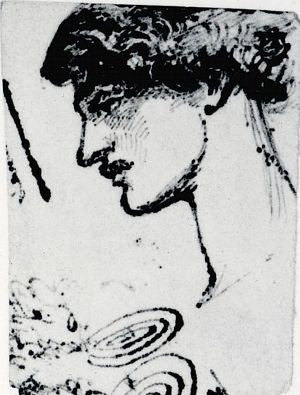The tree with the lights in it
 Annie Dillard's Pilgrim at Tinker Creek (1974) contains some of my favorite narrated details of all time. Ironically in all kinds of ways, I generally have a pretty rotten memory for details in books; though I can probably tell you, nearly word for word, what you said to me some random day in 1999, the names of characters in books I read a few months ago are, many of them, already gone. (To be sure, lots of the books I read a few months ago--Tom Wolfe, I'm thinking of your latest--are not such good books, and the disappearance of their characters' names has made room for incomparably more important things.) I compensate for this particular memory problem in all kinds of ways. But the point I'm gearing up for here is that I know Dillard's book made an impact on me because I still remember so much of it, and I haven't read it in at least a decade.
Annie Dillard's Pilgrim at Tinker Creek (1974) contains some of my favorite narrated details of all time. Ironically in all kinds of ways, I generally have a pretty rotten memory for details in books; though I can probably tell you, nearly word for word, what you said to me some random day in 1999, the names of characters in books I read a few months ago are, many of them, already gone. (To be sure, lots of the books I read a few months ago--Tom Wolfe, I'm thinking of your latest--are not such good books, and the disappearance of their characters' names has made room for incomparably more important things.) I compensate for this particular memory problem in all kinds of ways. But the point I'm gearing up for here is that I know Dillard's book made an impact on me because I still remember so much of it, and I haven't read it in at least a decade.In her second chapter, "Seeing," Dillard relates that she's been reading Marius von Senden's Space and Sight, which collects narratives from patients who, blind from birth, have their sight restored through cataract surgery. "The vast majority of patients," Dillard writes, "of both sexes and all ages, had, in von Senden's opinion, no idea of space whatsoever. Form, distance, and size were so many meaningless syllables.... Before the operation a doctor would give a blind patient a cube and a sphere; the patient would tongue it or feel it with his hands and name it correctly. After the operation the doctor would show the same objects to the patient without letting him touch them; now he had no clue whatsoever what he was seeing. One patient called lemonade 'square' because it pricked on his tongue as a square shape pricked on the touch of his hands." Heartachingly poignant stories keep on coming, until Dillard reaches a little girl, who helps her make the point that "many newly sighted people...teach us how dull is our own vision." Von Senden describes this little girl's experience in a garden: "She is greatly astonished, and can scarcely be persuaded to answer, stands speechless in front of the tree, which she only names on taking hold of it, and then as 'the tree with the lights in it.'"
I'm thinking a lot about the tree with the lights in it today, in part because I picked up my new/old glasses--same old frames, but new prescription--and am experiencing the standard new prescription strangeness that many of you may know. The center of my vision is, for the most part, improved; things are sharper, and I can see details farther off. But my peripheral sight is still a bit wacky; I have little doubt that this wackiness has something to do with the correction of a relatively new development in my sight that caused me to see double while I was in the optometrist's chair. I also have little doubt that my eyes will get the hang of being pulled around in a new way and that by tomorrow I won't notice anything strange anymore. But in this meantime, I find myself thinking, what if this is the beginning of the end of my normal sight? What if the lenses are somehow wrong, or if my eyes are becoming irreparably wrong? It's a startling, even (if I may) an eye-opening thought.
I'm also thinking about the tree with the lights in it because I happen to have seen the tree--actually, three iterations of it--in Gambier during the years I've lived here. About a decade ago, my parents were in town visiting for a weekend, and my father took many pictures of fall foliage, which is blazingly, wondrously beautiful here. One of the images he captured was of a tree at the side of a road, with the sun lighting its leaves from behind, not unlike the way the sun illuminated yesterday's curtains (and today's, as well; good fortune abounds this week). Its composition matched the little girl in Dillard's book so nicely that I used her quotation of von Senden as that picture's caption and hung it on my wall for the rest of my college career.
 Every November, Gambier sets up a different kind of tree with the lights in it, in the form of the community Christmas tree. For years and years, the tree stood beside the Kenyon Inn, one of our local hotels. It was an immense fir, and the lights were full-on light bulbs. When the tree was lit, you could see it from afar as you drove in on the highway, which routes you down a hill, into a river valley, before shunting you off up another hill to campus. When I was in graduate school, I spent a weekend in Gambier nearly every holiday season, on my way to my family's house. One year, hurtling down OH-229 and dreaming of the Indian food awaiting me at my friends' house, I realized with a start that I couldn't see the tree. Where had it gone? As I crawled up the hill to campus, I was finally able to see it, but it had... moved? What? It turned out that one of our many thunderstorms had brought the old tree down, and the new tree was a much smaller substitute across the road. The holiday season has not been the same since.
Every November, Gambier sets up a different kind of tree with the lights in it, in the form of the community Christmas tree. For years and years, the tree stood beside the Kenyon Inn, one of our local hotels. It was an immense fir, and the lights were full-on light bulbs. When the tree was lit, you could see it from afar as you drove in on the highway, which routes you down a hill, into a river valley, before shunting you off up another hill to campus. When I was in graduate school, I spent a weekend in Gambier nearly every holiday season, on my way to my family's house. One year, hurtling down OH-229 and dreaming of the Indian food awaiting me at my friends' house, I realized with a start that I couldn't see the tree. Where had it gone? As I crawled up the hill to campus, I was finally able to see it, but it had... moved? What? It turned out that one of our many thunderstorms had brought the old tree down, and the new tree was a much smaller substitute across the road. The holiday season has not been the same since.However: a couple of years later, driving in for yet another holiday weekend, I turned the corner at the top of the hill, into downtown Gambier, and discovered a block of trees laced with light. Turns out that an undergraduate had said to our associate dean of students, "You know what would be cool? White lights in the trees along Middle Path." Middle Path is the spine of our campus, a gravel path that runs a mile from end to end and ties Kenyon and tiny Gambier together. And every year since then, the white lights have gone up on the trees in town (at the middle of Middle Path) in mid-November and stayed up through the winter.
 Tonight, I went out to catch a few images of these trees and was struck by how quiet things have gotten all of a sudden. Exams ended at 4:30 this afternoon, but most students had cleared out by this morning; a last few are still here, preparing to leave tomorrow. Gambier has about 2100 residents when our 1500 students are on campus; their exodus makes a big difference. For one thing, vehicular traffic dwindles, which made it a lot easier to take these pictures than it would have been otherwise. I didn't realize how cold it had gotten, either, until my fingers started to hurt, even though I was wearing gloves. Once the pain started clutching its way in, I got a little shaky, which I think made for a nice, if inadvertent, effect. (I'm the sister of a mighty hip photographer, though, so I generally add an implicit question mark to such statements about photographic aesthetics.)
Tonight, I went out to catch a few images of these trees and was struck by how quiet things have gotten all of a sudden. Exams ended at 4:30 this afternoon, but most students had cleared out by this morning; a last few are still here, preparing to leave tomorrow. Gambier has about 2100 residents when our 1500 students are on campus; their exodus makes a big difference. For one thing, vehicular traffic dwindles, which made it a lot easier to take these pictures than it would have been otherwise. I didn't realize how cold it had gotten, either, until my fingers started to hurt, even though I was wearing gloves. Once the pain started clutching its way in, I got a little shaky, which I think made for a nice, if inadvertent, effect. (I'm the sister of a mighty hip photographer, though, so I generally add an implicit question mark to such statements about photographic aesthetics.)When I opened Pilgrim at Tinker Creek earlier, I lit first on a line that could describe me as well as it does Dillard, so I'm claiming it on this solstice eve: "I like the slants of light; I'm a collector."


4 Comments:
you're just beautiful! i'm having a horrid time trying to write a halfway decent paper for one of my philosophy classes, and your blog reminded me not only of how tremendous annie dillard is, but also that plenty of people appreciate a worldview that falls outside the bounds of formal, instrumental logic. your blog seems quirky and delightful.
I've been writing a poem and wanted to find the exact phrasing that Dillard used -- I lent my book and it never came back (a good sign, no?). So I just googled it and up came your lovely blog. Thanks.
If I may reply to the first person named Anonymous .
I too love the book 'Pilgrim At Tinker Creek' by Annie Dillard, and the characterization of it as being outside the bounds of formal logic , just doesn't fit, if by outside you mean ...against it. For the main observations I recall in that amazing and edifying book, are *not* contrary to formal logic .
Sincerely ,
Jason L.
Thanks for the Annie Dillard comments, especially about her ability to render detail in such a memorable way...I'm sure you remember the Polyphemus moth in the mason jar, and the crumpled frog skin...perhaps your life was changed by awareness of the number of muscles in the head of the ordinary goat moth!
Post a Comment
<< Home